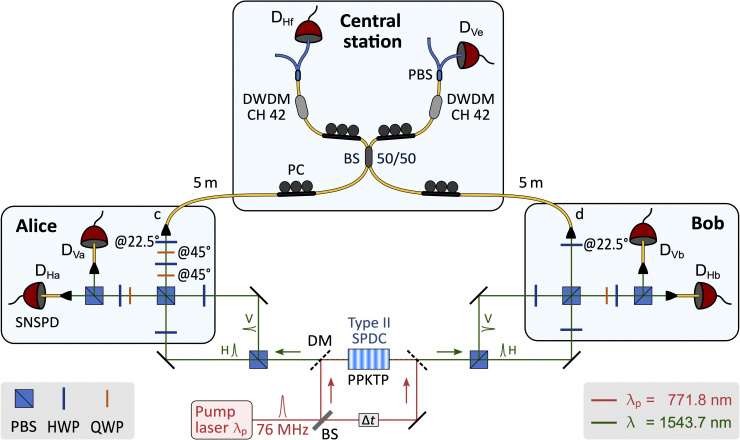Toward Heralded Distribution of Polarization Entanglement
F. Joseph Marcellino, Patrik Caspar, Tiff Brydges, Hugo Zbinden, Rob Thew
Optica Quantum 2(3), pp. 181-188 (2024)
You can read the full article here.
One of the most interesting properties of quantum systems with multiple parts is that they can be "entangled", meaning that the state of each part of the system is not well-defined on its own, but only in combination with the other parts. This entanglement can be a useful resource for many quantum communication protocols, allowing for things like unconditionally secure cryptographic key distribution. However, a prerequisite for such protocols is that we first actually manage to create entangled states and distribute the various parts to the different parties that want to communicate. One of the most promising ways to create entangled states for distribution is using single photons, since these can be easily transmitted over optical fibers. However, the distance over which these single photons can be distributed is limited, due to the intrinsic losses of fibre.

Classically, this loss in fibre is overcome by using components such as amplifiers. However, as an arbitrary quantum state cannot be cloned, amplifiers cannot be used when it comes to quantum commnication. Instead, we can use so-called "quantum repeaters", which work as follows. If we have two separate pairs of entangled photons, we can perform a joint measurement on one photon from each pair that causes the remaining two photons, initially totally independent, to become entangled in a "swapping" process. Now suppose we want to share a pair of entangled photons between two distant locations. By using many repetitions of this swapping process between photon pairs generated at regular intervals between our two locations, we can construct a network such that no single photon ever has to traverse too much fiber.
In this paper, we demonstrate the elementary building block of such a system, where we generate two entangled pairs and swap the entanglement between them. Importantly, this scheme is compatible with next-generation photon sources that allow for higher rates and better quality photons. We also identify important practical problems inherent to the scheme and extensively model their effects on the final quantum state, providing a guide for future implementations.
This work demonstrates a promising approach for the preparation and distribution of high-fidelity heralded entangled states in future quantum networks.